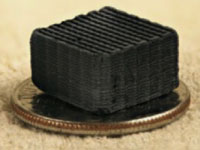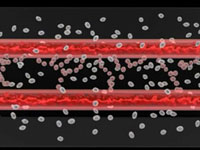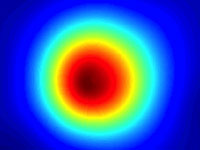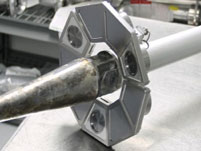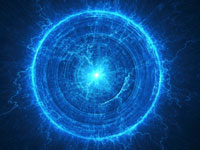In FY15, the LDRD Program at LLNL continued to be extremely successful in supporting research at the forefront of science, technology, and engineering, providing new concepts for core missions, and creating an exciting research environment that attracts and retains outstanding talent for the Laboratory.
Wide-ranging projects for this fiscal year exemplify LDRD’s noteworthy research in support of the Laboratory's long-range strategic science and technology plan, the Investment Strategy for Science, Technology, and Engineering, as well as for critical national needs. Here, we provide highlight examples of research projects that are supporting the strategic focus areas and core competencies that represent the LDRD Program research categories:
- Advanced Materials and Manufacturing
- Bioscience and Bioengineering
- Chemical and Biological Security
- Cyber Security, Space, and Intelligence
- Energy and Climate Security
- High-Energy-Density Science
- High-Performance Computing, Simulation, and Data Science
- Inertial Fusion Science and Technology
- Lasers and Optical Science and Technology
- Nuclear, Chemical, and Isotopic Science and Technology
- Stockpile Stewardship Science
Advanced Materials and Manufacturing
“Deterministic Multifunctional Materials and Manufacturing Initiative” (project 14-SI-004) is developing an understanding of the invention, development, and physical and chemical properties of new additive manufacturing processes, as well as advancing the state of the art in design of material architectures.
Additive manufacturing creates the potential to engineer materials possessing desired structural, thermal, electrical, chemical, and photonic properties in a single package. With project 14-SI-004, "Deterministic Multifunctional Materials and Manufacturing Initiative," researchers are seeking to develop and thoroughly understand new design methodologies and manufacturing techniques that will enable specific multifunctional materials with mission-relevant applications ranging from stockpile stewardship to global security to nuclear fusion ignition. In an April 2015 issue of Nature Communications, the team presented a general strategy for fabrication of periodic graphene (carbon) aerogel microscopic-scale lattices via three-dimensional printing. Key factors for successful three-dimensional printing of aerogels included modifying the graphene oxide precursor suspension so that it serves as printable ink, and adapting the printing process to prevent premature drying of the printed structure. By addressing these issues, three-dimensional printed aerogel microscopic lattices were produced with properties that met or exceeded those of bulk aerogel materials. The graphene micro-lattices possess:
- Large surface areas
- Good electrical conductivity
- Low relative densities and super compressibility
- Much stiffer properties than bulk graphene of comparable geometric density
By modifying the microstructure and density of the graphene aerogel through changing the ink formulation, the team also showed how mechanical properties of the micro-lattices can be tuned. Because graphene aerogels are currently being explored for a broad range of applications, such as energetic materials for defense uses and materials for high-energy-density targets for fusion energy research, having a manufacturing method for creating periodic or engineered structures using this novel material can further expand the range of applications to support Livermore’s missions in national and energy security.
Collaborations
Harvard UniversityUniversity of Illinois, Urbana-Champaign
University of California, Los Angeles
Bioscience and Bioengineering
“Biological Printing of Vasculature for Artificially Grown Tissue” (project 14-ERD-005) is using biological printing methods to assemble sophisticated capillary networks that can deliver nutrients through thick human tissue.
The cardiovascular system is a complex web of tens of thousands of miles of arteries, capillaries, and veins, branching throughout the body like tributaries of a river. LDRD researchers at LLNL are recapitulating this intricate network using the emerging technology of three-dimensional biological printing with project 14-ERD-005, “Biological Printing of Vasculature for Artificially Grown Tissue.” The project’s goals include:
- Development of printable biological ink
- Coaxial printing and extrusion of a biological vessel
- Vascular-membrane tissue characterization
- Perfusion studies for homogenous distribution of nutrients through multiple layers of thick tissue
The team’s research could enable the first sustainable platform of networks capable of distributing oxygen and nutrients homogenously through several layers of tissue, with the use of only natural biological materials. Using a three-dimensional printer and a biological-ink made of materials compatible with the human body, the team has successfully printed structures with living cells and biomaterials. The material and environment are engineered to enable small blood vessels (human capillaries) to develop on their own. This process is lengthy, and initially, tubes are printed out of cells and other biomaterials to deliver essential nutrients to the surrounding printed environment. Eventually, the self-assembled capillaries are able to connect with the bio-printed tubes and deliver nutrients to the cells on their own, enabling these structures to function as they do in the body. The precision and three-dimensional structures made possible through biological printing will enable researchers to more effectively reproduce human physiology outside of the body, and will eventually lead to a better representation of each tissue system that makes up the human body. Biological printing is synergistic with another LDRD project aimed at replicating the body on a microscopic scale. That project, known as iCHIP (in vitro chip-based human investigational platform), re-creates and integrates the central and peripheral nervous systems, the blood–brain barrier, and the heart (14-SI-001).
Collaborations
Harvard UniversityAnabios Corporation
Chemical and Biological Security
“Rapid Detection and Characterization of Emerging Foreign Animal Disease Pathogens” (project 14-ERD-081) is developing new and effective surveillance technologies for early detection of known, emerging, and new foreign animal disease outbreaks.
Many of the diseases affecting the commercial swine industry involve complex syndromes caused by multiple pathogens, including emerging viruses and bacteria. A swine fever outbreak in the Netherlands in 1997 cost about $2.3 billion to eradicate. In addition, swine fever is also a disease of concern for biological warfare. In a study appearing in the April 2015 Journal of Veterinary Diagnostic Investigation, LDRD researchers report on the utility of the Lawrence Livermore Microbial Detection Array (LLMDA) for detection of known and unknown microbes in blood, saliva, and tonsil tissue from pigs experimentally infected with two porcine viruses. Initial support for development of the array was provided by the LDRD viral identification and characterization initiative (08-SI-002). The current effort in applying this technology to animal husbandry is supported by the LDRD project, “Rapid Detection and Characterization of Emerging Foreign Animal Disease Pathogens” (14-ERD-081). The project’s goals are to:
- Develop new and effective surveillance technologies for early detection of known, emerging, and new foreign animal disease outbreaks
- Enable biomarker discovery
- Transition the technologies to national agricultural laboratories
The LLMDA easily identified the two experimentally induced diseases, but at decreased sensitivities compared to standard polymerase chain reaction methods. Although polymerase chain reaction technology is more sensitive, typically only a handful of microorganisms can be identified in a single test. A key advantage of LLMDA over other detection technologies is that it can detect within 24 hours any bacteria or viruses that have been previously sequenced. The current version of the LLMDA has the capability to detect about 8,100 microorganisms, including 3,855 bacteria and 3,856 viruses. Early detection of disease outbreaks is crucial to the effective surveillance of emerging infectious diseases to safeguard both animal and human health.
Collaborations
Kansas State UniversityCyber Security, Space, and Intelligence
“Cooperative Constellations: Resilient, Persistent, and Flexible Satellite Systems” (project 14-SI-005) is designing and building individual miniaturized satellites to develop the key enabling technologies to demonstrate that cooperative constellations of small satellites can perform space missions important for U.S. national security.
Space remains vital to our national security, but the evolving strategic environment increasingly challenges U.S. space advantages. The nation's space capabilities allow our military to see with clarity, communicate with certainty, navigate with accuracy, and operate with assurance. A team of LDRD researchers has proposed to develop the concepts, technologies, and models to demonstrate cooperative constellations of milk-carton-sized satellites to perform space missions for a variety of missions. With project 14-SI-005, "Cooperative Constellations: Resilient, Persistent, and Flexible Satellite Systems," they are applying the Laboratory's significant modeling and simulation capabilities to design and build individual miniaturized satellites. These will be used to develop the key enabling technologies to demonstrate that cooperative constellations of small satellites can perform high-priority missions. They will validate the ability to accurately model instrument performance, create new imaging and sensing concepts, and demonstrate how to synthesize data from multiple satellites. A goal is to operate Pathfinder satellites, develop active and passive techniques for control and learn how to fly and maintain formations of these low-mass satellites, and study optimal constellation configurations and develop enabling technologies for various applications. In FY15, they:
- Focused on the development of new optics technologies, modeling and simulating their performance, directly characterizing the optics, and using these results to validate and refine performance models
- Created detailed designs of several potential payloads that could be used for a variety of national security applications, including space situational awareness and earth observations
- Initiated a CRADA (cooperative research and development agreement) with a small company to develop new star trackers
Collaborations
National Aeronautics and Space Administration Goddard Space Flight CenterEnergy and Climate Security
“Selecting Better Models for Climate Change Detection and Attribution” (project 13-ERD-032) is developing novel measures of climate modeling performance, with an emphasis on metrics for variable space and time, feature identification and tracking, and multiscale analysis.
Livermore LDRD researchers are seeking to develop a rigorous, scientifically credible strategy for selecting models for use in climate change detection and attribution, which requires estimates of climate response to external forcing agents such as atmospheric trace gases, and climate "noise" for each model. Despite the importance of an accurate picture of noise, little work has been done to investigate the ability of different models to simulate observed spatial and temporal variability. With project 13-ERD-032, "Selecting Better Models for Climate Change Detection and Attribution," researchers are developing novel measures of model performance, with an emphasis on metrics for variability, feature identification and tracking, and multiscale analysis. This work leverages the Laboratory's proven capabilities in climate change detection and attribution, and in developing and applying climate model performance metrics. A suite of metrics is being developed to evaluate variability at different scales and use these metrics to evaluate the performance of the climate code CMIP-5 (Coupled Model Intercomparison Project, Phase 5). For the two-year project, the team of computational experts has:
- Applied analysis techniques they developed to model and observe trends in cloud cover
- Initiated work to explore the impact of human-induced forcing on the phase and amplitude of the annual cycle of atmospheric temperature
- Helped lay the precedent for an approach used in recent research to determine the effects of volcanic eruptions on climate
They demonstrated that a series of small 21st century volcanic eruptions have deflected substantially more solar radiation than previously estimated, and this can be detected in a variety of different observational data sets. The fact that these volcanic signatures are apparent in multiple independently measured climate variables provides strong support for the idea that they are influencing climate, despite the moderate size of the eruptions.
Collaborations
Massachusetts Institute of TechnologyMauna Loa Observatory
Russian Academy of Sciences, Moscow, Russia
National Center for Atmospheric Research
Helmholtz Centre for Polar and Marine Research, Bremerhaven, German
Columbia University
Meteorological Research Institute, Ibaraki, Japan
High-Energy-Density Science
“Generation and Characterization of Matter at Extreme Gigabar Pressures” (project 13-ERD-073) is developing a new model to simultaneously determine the mass density and opacity profiles from radiographic measurements, as well as creating a platform to probe the equation of state for a variety of materials relevant to stockpile stewardship and basic science.
With an LDRD project devoted to "Generation and Characterization of Matter at Extreme Gigabar Pressures” (13-ERD-073), investigators have measured the equation of state of matter at the highest pressures ever achieved in the laboratory. They have created matter at pressures approaching those found in the Sun’s core (gigabar range) by launching spherically convergent shock waves into solid polymer balls using a laser capsule radiation drive. Two different gas densities of helium were used in the gold capsule and it was driven by up to 184 laser pulses. The laser peak power and total drive energy were varied to access different pressure regimes along the Hugoniot stress–density–temperature relationship, to overlap with previous data and reach record pressures in the laboratory. The team characterized the shocked material using streaked x-ray radiography along the material’s equator with an x-ray back-lighter. Experiments were designed and analyzed with simulations using the HYDRA radiation-hydrodynamic code. Successful completion of the project has resulted in:
- The Hugoniot of various carbon compounds in the pressure range of 25 to 800 Gbar
- Measurement of the density-weighted electron temperature and carbon ionization state after shock coalescence using x-ray Thomson scattering and x-ray spectroscopy of the Bremsstrahlung self-emission
- Investigation of the equation of state of material at around 40 Gbar that occurs in the shock flash at the center of a sample using nuclear reactions, x-ray self-emission spectroscopy, and penumbral imaging (the shadow that a source casts through a large circular aperture) of the shock flash
A new platform developed for this project has been incorporated into a Livermore programmatic effort to measure the equation of state of various materials. In addition, basic science proposals motivated by this work to study the physics of matter at extreme conditions have recently been submitted to the National Ignition Facility Discovery Science program by outside leaders in the field, including the international community.
Collaborations
Nevada Terawatt Facility, University of NevadaGSI Helmholtz Centre for Heavy Ion Research, Darmstadt, Germany
SLAC National Accelerator Laboratory
University of California, Berkeley
High-Performance Computing, Simulation, and Data Science
“Task Mapping on Complex Computer Network Topologies for Improved Performance” (project 13-ERD-055) is developing models to understand network congestion on supercomputers and develop tools for mapping tasks in a parallel application to improve performance.
As processors have become faster over the years, the cost of computing operations has rapidly grown smaller. On the other hand, the cost of communicating data has become proportionately higher. Maximizing data locality and minimizing data movement, both on and off the server node, is critical to optimizing communication and overall application performance as well as reducing energy costs. With "Task Mapping on Complex Computer Network Topologies for Improved Performance” (13-ERD-055), LDRD researchers have developed:
- A better understanding of network congestion on the torus networks for compute clusters on supercomputers
- A methodology for highly accurate performance prediction using machine-learning models
- Tools for task mapping and performance improvements of production scientific applications
- Network simulators for performing “what-if” analyses
To measure congestion empirically on IBM and Cray supercomputer networks, the team developed libraries that can record network hardware performance counters on these platforms for recording information about network traffic. They developed a machine-learning approach to understand network congestion on supercomputer networks, and used regression analysis on communication data and execution time to find correlations between the two. Because creating task mappings is time consuming and difficult, the researchers developed tools and frameworks that create these mappings for application developers automatically. Another goal for their project was to investigate the sources of performance variability in parallel applications running on supercomputer platforms in which the network is shared between multiple jobs running simultaneously on the system. They found multiple cases where there was strong evidence that differences in performance were because of communication activities of competing jobs, with message passing rates up to almost 28% slower when surrounded by a communication-heavy application. Finally, because performance-prediction tools are important for studying the behavior of applications on large supercomputer systems that are not yet deployed, the team developed two methods for simulating the communication of high-performance computing applications on supercomputer networks.
Collaborations
University of Illinois at Urbana-ChampaignInertial Fusion Science and Technology
“Chemically Stable and Optically Transparent Vapor-Deposited Plastics” (project 15-ERD-020) is using chemical vapor deposition to synthesize polymers that are chemically stable and optically transparent using non-plasma synthetic vapor-phase strategies that mimic traditional synthesis, thus allowing tailored polymer properties while maintaining the advantages of chemical vapor-deposition processing.
The goal of LDRD project 15-ERD-020, “Chemically Stable and Optically Transparent Vapor-Deposited Plastics,” is to synthesize and cast polymers that combine the processing advantages of chemical vapor deposition (conformable coating, purity, solvent-free operation, and scalability) with the tailored material properties of traditionally synthesized polymers. These chemical vapor-deposition polymers will have a fundamental chemistry that is as simple, well characterized, and stable as polymers synthesized using traditional liquid-phase means. They will thus be more chemically stable and optically transparent than current plasma chemical vapor-deposition polymers. Chemically stable and optically transparent chemical vapor-deposition polymers would:
- Simplify laser target fabrication for fusion research
- Improve ablator performance by reducing x-ray opacity
- Enable detailed characterization of the critical fuel and ablator interface (an unsolved problem in target fabrication) for Inertial Confinement Fusion applications
Chemically stable and optically transparent polymers will also be broadly applicable as coatings for a variety of additional applications including optical, electronic, or biomedical devices. The team intends to develop a reactor capable of creating non-plasma chemical vapor deposition of polymers from organic gases. They are working to develop a process for synthesizing polymers that are greater than 80% transparent over the entire visible range through a 200-µm optical slab. In a 2015 Chemical Vapor Deposition article, the team reported on an unusual photoluminescence behavior of the plasma polymer and correlated it to photo-stability, creating a powerful new diagnostic for the photo-stability of polymeric and other materials. Furthermore, they concluded that removing monomer fragmentation from the polymerization pathway suggests a pathway for synthesizing chemically stable chemical vapor-deposition polymers. A non-plasma method such as initiated chemical vapor deposition is a good candidate because the film properties are not dependent on processes that damage the monomer. A non-plasma method may therefore offer a route to photochemically robust hydrocarbon polymers, enabling adoption in applications with long-term exposure under demanding operating conditions.
Collaborations
University of ConnecticutGeneral Atomics
Lasers and Optical Science and Technology
“Laser–Matter Coupling Mechanisms Under Varying Chemical and Particulate Surface Configurations” (project 14-ERD-098) is examining damage mechanisms from particulate contamination in optics used in advanced lasers, and exploring coatings or vapor chemistry treatments to limit damage.
Particulate contamination negatively impacts a wide range of high-performance materials and devices, including microelectronics, space optics, lasers, and nuclear reactors. Improved optical designs with contamination-mitigation strategies are needed for high-power laser systems. With LDRD project 14-ERD-098, “Laser–Matter Coupling Mechanisms Under Varying Chemical and Particulate Surface Configurations,” researchers are:
- Developing a test chamber and diagnostic suite for examining particle-driven damage to laser optics
- Conducting experiments with different particle–surface pairs, chemical environments, and laser conditions
- Simulating laser absorption, material response, and subsequent effects on laser beam propagation
- Exploring mitigation strategies, including pre-pulse laser cleaning, chemical passivation, and coatings
In an October 2015 cover issue of Applied Optics, the research team reports that thermal and mechanical calculations combined with optical modeling show that the large difference in thermal expansion coefficients leads to large differences in thermally induced mechanical stress between the protective cap layer and adjacent layer below in multilayer coatings for laser optics. In the case of an aluminum oxide cap layer, this mechanical stress is approximately 64 times greater than with silicon dioxide. Thus, silicon dioxide was shown to be a more effective material for use as a capping material to protect against debris-induced laser damage on high-power dielectric-coated mirrors. Thus far, the project has developed experiments that consisted of large-aperture laser tests where a large number of particles bound to optic surfaces could be tested at once, and have found a large asymmetry in optics damage behavior between material types. The team has also developed an enhanced understanding of material and morphological dependencies on subsequent damage in laser optics, and have characterized plasma temperature and electron density associated with contaminant material removal with laser ablation.
Collaborations
Laboratory for Laser Energetics, University of RochesterNuclear, Chemical, and Isotopic Science and Technology
“Radiochemical Measurements of Nuclear Reactions at the National Ignition Facility” (project 13-ERD-036) is developing a solid-debris radiochemistry diagnostic capability for measuring neutron activation cross sections and nuclear data in a plasma environment.
Neutron-capture cross sections at kiloelectronvolt temperatures are important for interpretation of radiochemical data for nuclear forensics and stockpile stewardship, yet they cannot be directly measured at traditional neutron facilities. For nuclear cross-section measurements at Livermore’s National Ignition Facility, the ability to collect solid debris needs to be improved, and selected materials for study have to be incorporated into the target assembly for activation, collection, and subsequent analysis. The LDRD project “Radiochemical Measurements of Nuclear Reactions at the National Ignition Facility” (13-ERD-036) resulted in platforms for measuring neutron reactions at the facility for nuclear forensics, stockpile stewardship, and nuclear astrophysics. The three objectives were to:
- Optimize the solid radiochemistry collectors
- Incorporate selected material into the target capsule assembly
- Measure neutron-capture cross sections for isotopes of yttrium, uranium, and thulium
Improved collection efficiency for solid debris was obtained by adding collectors to a diagnostic instrument manipulator and through deployment of the VADER (vast-area detection for experimental radiochemistry) large-area collector. Initial shots with rare earth foils added to the outside of the hohlraum target capsule thermal–mechanical package indicated that the hohlraum debris is highly directional, with almost no mixing occurring at the target chamber center. A target capsule was doped, for the first time, with a radiochemically active target of uranium-238, which was then collected via solid-debris collection. Results indicate that even a small amount of target atoms can produce a signal to measure nuclear reactions in a laser target capsule. By demonstrating the ability to perform nuclear science reactions at the National Ignition Facility, the team also introduced the external nuclear physics community to the possibility of performing experiments relevant to astrophysics using the facility’s platform. A collaboration with the University of Notre Dame in Indiana has been established to plan for future astrophysics experiments, based on the platforms developed under this project.
Collaborations
University of Notre DameStockpile Stewardship Science
“Self-Consistent, Three-Dimensional Calculations of Electromagnetic Pulse Propagation” (project 15-ERD-066) is developing self-consistent, three-dimensional calculations of nuclear-driven electromagnetic pulse propagation to enable simulation of high- or low-altitude nuclear bursts, including geomagnetic effects and complex geometries.
Modern assessment of electromagnetic pulses is essential for developing nuclear forensic capabilities based on signals measured in both urban settings and space, predicting the propagation of pulses through the upper atmosphere, and establishing improved radiation-hardening standards. Energetic gamma rays emitted by nuclear reactions propagate through the atmosphere until they interact with neutral atoms, producing ions and energetic Compton electrons, which is the scattering of photons from electrons. The electrons turn in the Earth's magnetic field, generating a coherent current that produces a large electromagnetic signal. With the LDRD project, "Self-Consistent, Three-Dimensional Calculations of Electromagnetic Pulse Propagation” (15-ERD-066), researchers are working to develop calculations of pulse propagation, including:
- Detailed descriptions of geometry
- Compton electron motion
- Gamma shadowing
- Electron avalanche
- Evolution of the background medium
The team has identified three developments that offer promise for qualitatively improved simulation capabilities including (1) a separation of scales to enable detailed three-dimensional simulations for use on a broad set of electromagnetic pulse scenarios, (2) a combination of adaptive mesh refinement and particle-in-cell models for simulating a front that travels a long distance through free space before encountering an urban environment involving finer-scale structures, and (3) a mathematical solver to enable full three-dimensional propagation over distances not previously deemed practical. In FY15, they developed a model for calculating the electromagnetic pulse field without the conduction current. This allows scattering, drag, and contributions from electromagnetic radiation from the radial acceleration of charged particles to be examined individually and together, a capability absent in current equation-based codes. Investigators also examined the effect of multiple scattering on the Compton recoil current using analytic and numerical approaches. A simplification used in legacy codes was found to neglect skewing (asymmetry) in the velocity distribution produced by electron motion and multiple scattering. Finally, they developed physics modules for the three-dimensional electromagnetic particle-in-cell code and have begun initial simulations.


